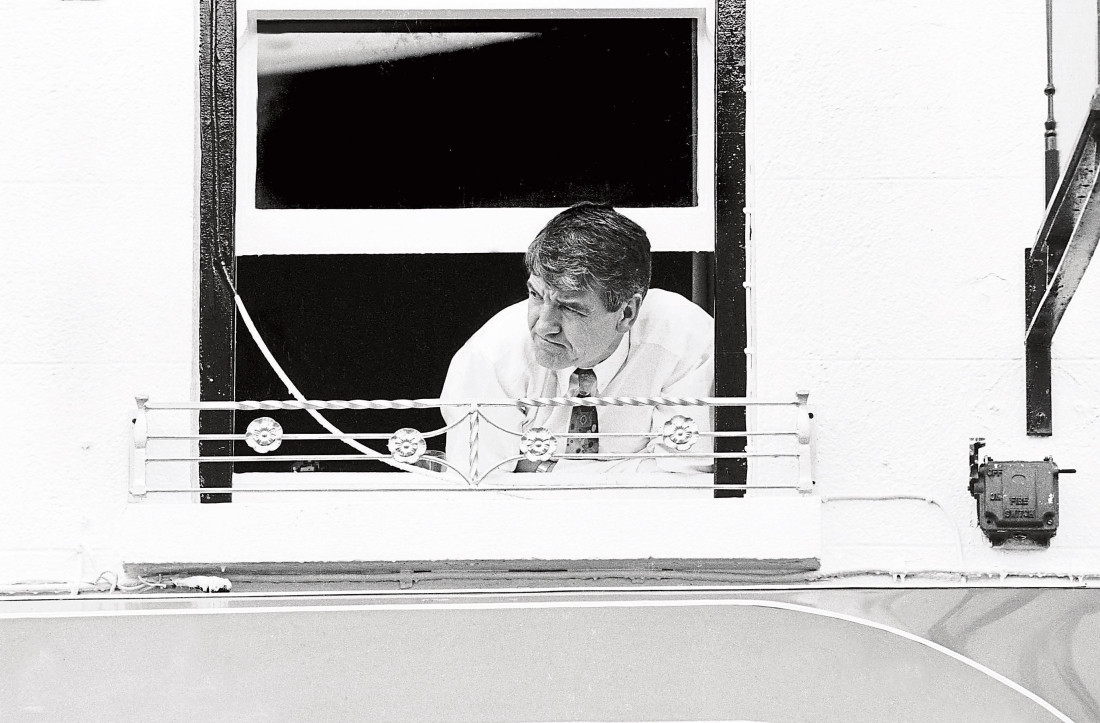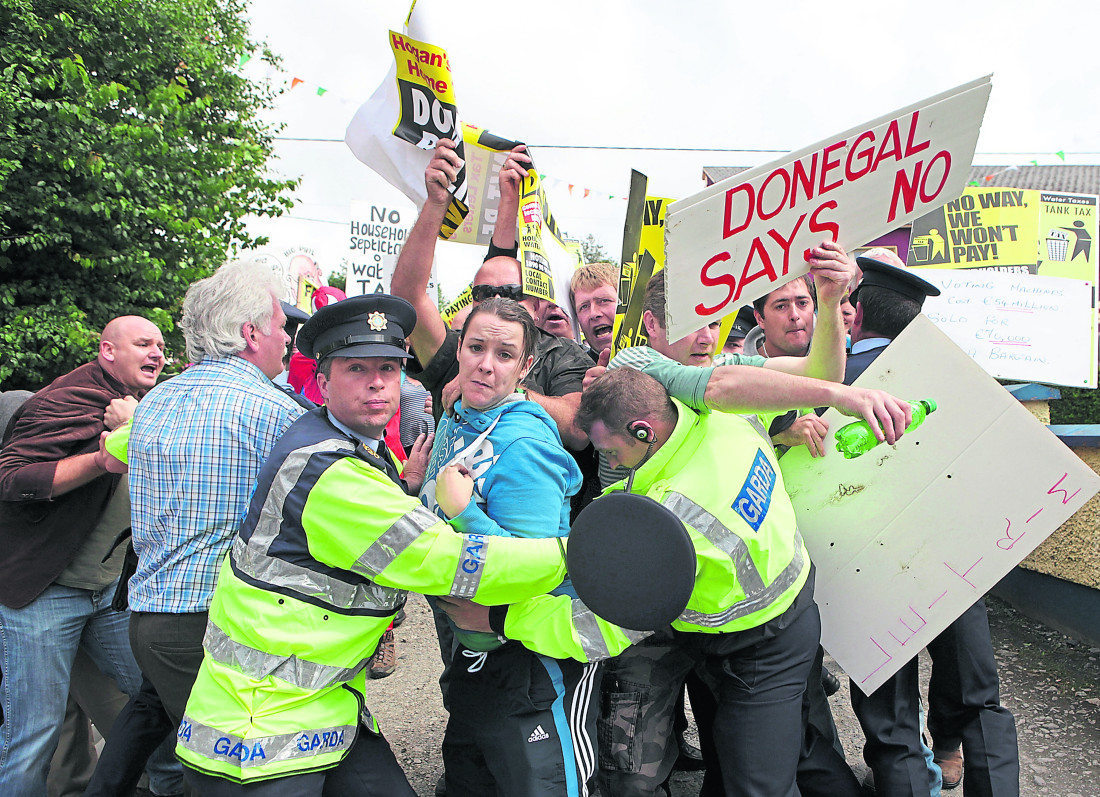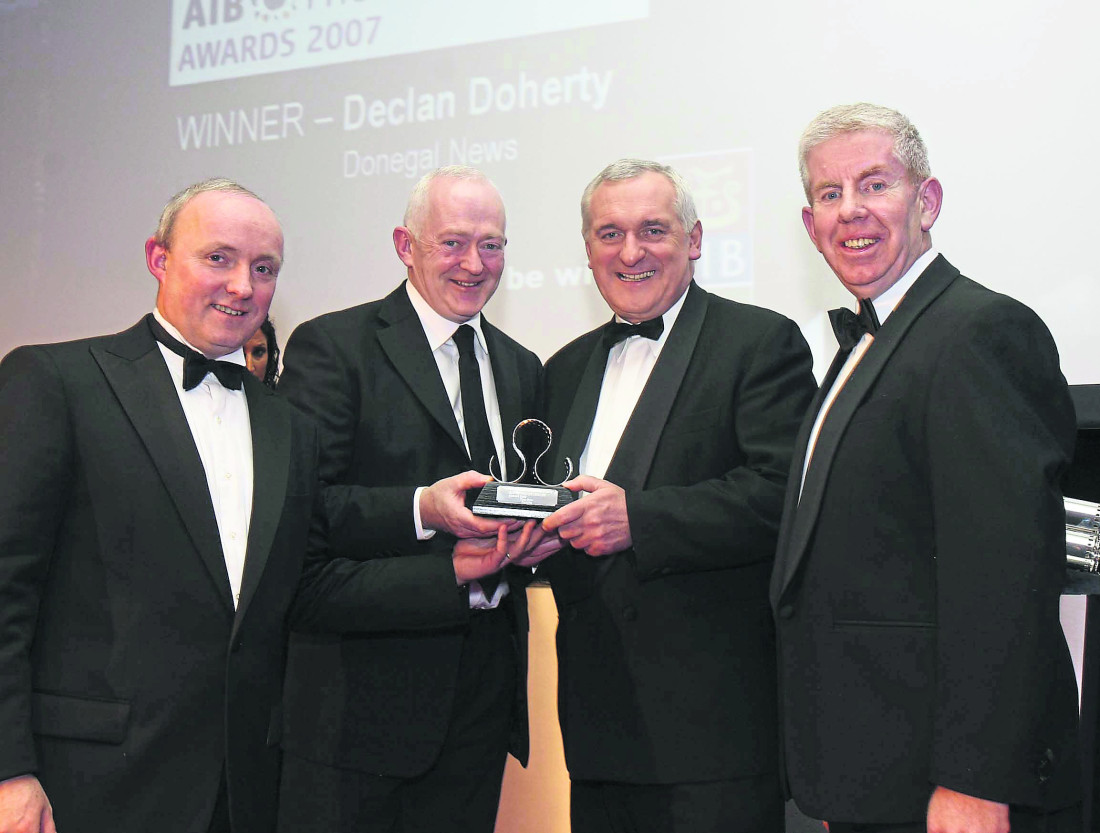by Louise Doyle
FOR 44 years, former Donegal News photographer Declan Doherty has been behind the lens bringing to life stories of happiness, tragedy and the very ordinary.
An exhibition of the award-winning press photographer’s work previewing tonight in Donegal County Museum will be nostalgic for many people, allowing them to walk down memory lane of yesteryear in Donegal.
‘Life Through The Lens’, which is part of the Earagail Arts Festival, officially opens tomorrow and will run until the end of August in the Letterkenny-based museum.
A chance conversation with one of the museum’s curators, Caroline Carr, put the exhibition wheels in motion for the Ard O’Donnell native with an unrivalled eye for detail.

Businessman and pharmacist, the late Jim McCormick, casts an eye over the Letterkenny Folk Festival carnival parade from the window of Magees Chemist on the town’s Main Street.
Speaking to the Donegal News, Declan said the exhibition features a wide range of familiar faces and many of the town’s much-loved residents, some sadly no longer with us.
“There are some timeless photos in the exhibition. There’s a black and white photo of pharmacist Jim McCormick looking out the window of his premises on main street during one of the festivals in the town. Jim did so much in terms of the Tidy Towns Committee. He was instrumental in Letterkenny winning the overall award in 2015. He was a linchpin.
“It was an offbeat photo, Jim didn’t even know it was being taken at the time. I think those are probably the best images.”
Plenty of humour will be found in the exhibition also, including a photo of a topless Daniel O’Donnell at a fashion show in Letterkenny a number of years ago.
But a photograph can also hold so much power and influence change. Declan experienced this when he scooped ‘best features’ picture award for his photograph of a car dump on Arranmore Island in 2007 titled, ‘Carmageddon’.
“It was a shot of hundreds of old abandoned cars on Arranmore Island in 2007. The cars had been brought onto the island and used by islanders until their end of life. They were all parked in a ‘car park’ at the back of the island. As a result of the photo appearing in one of the national newspapers, a campaign got going to remove them. The council got involved and they appointed a scrap metal contractor to remove the cars.
“It had become a bit of an eyesore, and looking back on it now it’s not the sort of image that you would have wanted the island to have portrayed.”
RP Mehan, who ran Barr’s Newsagents on the Main Street, also features in the photo exhibition.

RP Mehan who features in the photo exhibition ‘Life Through the Lens’ at Donegal County Museum during this year’s Earagail Arts Festival.
“The Derry People Donegal News would come to newsagents in the town on a Thursday and the rest of the county on a Friday. People would queue up outside Barr’s Newsagents on a Thursday evening in the 90s for a copy of the paper. Mr Mehan would keep the shop open until the papers arrived, within reason. It was an amazing sight.”
There were many difficult and heartbreaking days too for Declan, who first joined the newspaper in its Rosemount Lane office in 1979 as a cub photographer under the then editorship of Pat McArt.
“One of the hardest things was the Skifjord tragedy in 1981 when five fishermen including a father and his son lost their lives in St John’s Point in Dunkineely. I remember being sent over to cover that, not knowing what to expect. As I approached I saw a very lonely figure on the pier. It was Joey Murrin, leader of the Fisherman’s Union at that time. None of the bodies had yet been recovered, but Joey stood there.
“Road tragedies were hard to cover, as was the Buncrana Pier tragedy. It would break your heart, all of it.
“I really enjoyed covering the elections and the counts. It was great going out with the candidates when they were canvassing on the doorsteps because you heard first hand about the problems people had.
“The counts were so interesting before the arrival of technology, when the tallies fell to the very very skillful tally people, and still do to this day. The late Danny McGlinchey of the Fianna Fail camp, was the tally man for a lot of general elections. You would see the swings and the numbers every few minutes. Back then, there as no physical barriers, people were literally leaning over the table.”
Having initially been interested in a career in journalism, Declan planned to go to college in Galway to undertake a degree but following a night time course at the then Regional Technical College, he accepted a job as a photographer with this newspaper.
“One week rolled into the next, and then family was coming along so I stayed in my job,” said Declan.
“The dark and dreary 80s were then upon us. Recession hit and unemployment was very high. If you had a job in the 80s you held on to it. For a long time there was no light at the end of the tunnel until the country started to pick up economically towards the late 80s and early 90s.”
Despite the reach of social media, Declan said he believes newspapers and photographs are continuing to tell their own story.
“When I started there was no social media. We developed our own films at the time. It was a great learning curve. The late Jackie Sloan would have come and given me half an hour’s training on how to develop a film. It was probably the longest ten minutes of my life until I pulled the film out and saw there were images on the negative. I really enjoyed processing the films and images appearing on the photographic paper in the dark room. It’s actually something that I would like to get back into.
“I think there is still a space for that type of photography. I think they still teach it at some journalism colleges. Before you go out with a camera, even in a digital age, you have to understand where it all came from.”

Gardai struggle to contain a protest against the introduction of a Houshold Charge tax back in 2012. This one off tax was later replaced by a property tax.
Declan has been very much part of the fabric of this newspaper, moving with the team from Rosemount Lane to Market Square, then onto Crossview House, St Anne’s Court and the newspaper’s current office in Riverside Retail Park.
“When I first started, Pat McArt was the editor, or chief reporter as they were known them. Reporter Connie Duffy was there, as was Suzanne Rodgers and Maggie Breslin was front of office. Pat McArt left to take up a job in RTÉ, and George Jackson took over as editor followed by John McGroary, Columba Gill, Laura McLoughlin and now Diarmaid Doherty.
“I think the paper is still very important to the people from the town and in west Donegal.”
A familiar face with a trusted vision, Declan is very much missed by all his colleagues. He too says he misses being a staff photographer.
“I miss meeting people from day to day. I loved meeting people on the road on the way or from a job. People were very good because a lot of the time you were taking photos of people who didn’t necessarily want their photo to be taken but once you gained their trust they would tell you their whole life story.
“I met a lot very interesting people and celebrities too. But the ordinary people turned out to be the most interesting,” said Declan.
Judith McCarthy, Museum Curator, said: “We have worked with Declan over many years, both as a press photographer and on commissions for exhibitions.
He has an eye for the unusual but also for the ordinary everyday life of people in Donegal which make his photos so evocative.
“Photographs often speak louder than words and play an integral role in telling the story of our past – even more so now that people take thousands of photos on their phones without actually considering the content.
“Earagail Arts Festival is a wonderful opportunity to showcase Declan’s work not just to a local audience but to those who travel from further afield for this unique and special Festival.”










